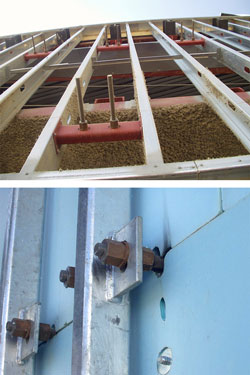Composite Wall Support System Creates Thermal Break Advantages
 From highs in the summer pushing 90 degrees F to winter lows in the range of -40 degrees F, the Alaskan climate creates a unique challenge for engineers and architects with its dynamic annual temperature swings.
From highs in the summer pushing 90 degrees F to winter lows in the range of -40 degrees F, the Alaskan climate creates a unique challenge for engineers and architects with its dynamic annual temperature swings.
One of the concerns with permanent building construction and design within challenging climate conditions has always been thermal conductivity thru metal-to-metal fastenings and components of exterior walls. When too much thermal transference occurs, interior condensation often results, which can lead to mold growth. Steel, as a building material, offers reasonable thermal performance compared to other materials such as copper (10 times of steel) and aluminum (6 times of steel). However, FRP (.01 times of steel) can yield significant energy savings and help avoid other problematic conditions related to condensation when utilized as a thermal break to maintain both the temperature and the energy efficiency within a building.
Bassett Army Community Hospital was completed in Alaska in 2005 by the architectural joint venture HKS, Inc./Wingler & Sharp. The project’s chief structural engineer, Larry A. Johnson, P.E., designed a structural solution that minimized the thermal conductivity thru the exterior components of the exterior walls. The solution resided in an FRP design using composite structural members which bolted to the spandrel beams of the project’s structural steel framing system. The FRP design was made up of EXTREN® 12” x ½” FRP wide flanges, EXTREN® 8” x 2- 3/16” x 3/8” FRP channels and FIBREBOLT® ¾” FRP threaded rods and hex nuts to support the exterior masonry façade/cladding and bridging the gap as a thermal break between the warm and cold sides of the exterior wall.
In situations and climates where drastic temperature variations occur, the materials chosen are critical to efficient building and structural designs. EXTREN® FRP Structural Shapes were chosen as the best material for this job due to EXTREN®’s advantages in its thermal properties in conjunction with its density, tensile/flexural strength and modulus of elasticity.
Click here to view the case study.